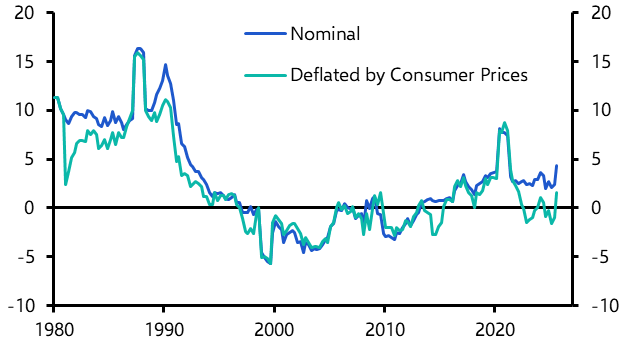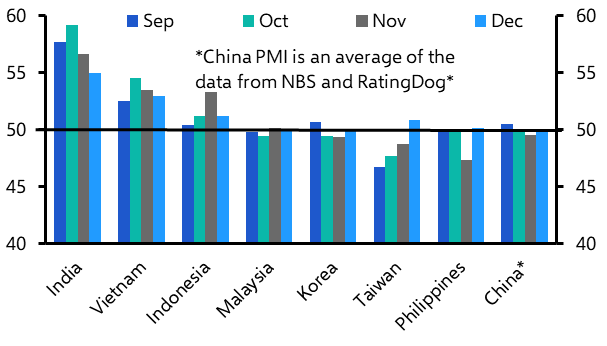Another week, and another set of figures that suggest China’s economy has begun to find its feet. Last week’s release of activity data for March showed that, having slowed for the best part of a year, conditions in the world’s second largest economy are now starting to improve. This follows an improvement in March’s trade data (released earlier this month) and, before that, a rebound in China’s manufacturing PMIs.
All of this reinforces a point that our China team has been making for a while – namely that policy support would ultimately put a floor under the slowdown in growth that began (at least according to our own China Activity Proxy, or CAP) in mid-2018. This has naturally led clients to ask: what will the subsequent recovery look like?
Our China service is the place to look for detailed analysis but the short point is that, while the monthly data are likely to bounce around, we don’t really expect a meaningful recovery in growth over the next 6-12 months. Policymakers in Beijing are more cognisant now than in the past of financial vulnerabilities stemming from rising debt levels. Accordingly, the scale of policy stimulus this time has been much smaller than in previous downturns. Beijing has done enough to stabilise the economy but investors betting on a vigorous recovery in growth are likely to be disappointed.
Meanwhile, there is a potentially much bigger issue rumbling along in the background that’s received much less attention. As we’ve argued in the past, China has been facing two slowdowns: a cyclical one, and a structural one. Policy stimulus can counter cyclical weakness. But China’s structural challenges require a different response, focused on addressing deeper-seated constraints that have built in its economy.
As things stand, there is little evidence that policymakers have an appetite for the reforms needed to reverse China’s secular decline in productivity growth. Accordingly, while overall GDP growth will fluctuate across the cycle, it will remain on a downward trend over the long run. We’ve argued that annual GDP growth could fall to as low as 2% over the next 10-15 years.
At first sight this sounds like an existential threat to the rest of the world economy. After all, the sheer size of China means that a slowdown in its growth rate from around 5% a year on our CAP measure now to 2% over the next decade or so would, on its own, shave about 0.5%-pts off annual global GDP growth. What’s more, a combination of a falling investment rate and persistently high savings rate means that (contrary to the prevailing consensus) we suspect that China’s current account surplus may actually rebound as growth slows. This would be a drain on demand in the rest of the world.
However, in practice the implications for other economies of China’s long-term slowdown is likely to be more nuanced than the headline numbers suggest. For the US, Europe and other developed economies the headwinds posed by a slowing Chinese economy over the long term are in fact likely to be overwhelmed by other factors – most notably whether the development of digital technologies ultimately feed into faster productivity growth. In contrast, industrial commodity producers (particularly in Latin America and Africa) are likely to bear the brunt of China’s structural weakness as demand for the raw materials that were sucked in by its investment boom over the past decade wanes. (For more on all of this, readers should refer to this recent publication.) Either way, the key point for investors is to not lose sight of the fact that, while the near-term outlook for China appears to have improved a bit, the long-term challenges remain daunting.
In case you missed it:
(Requires login)
- Our Senior US Economist, Michael Pearce, takes a sceptical view of the latest decline in jobless claims.
- Our Europe team has published its latest European Economic Outlook, which includes an eye-catching call on the ECB.
- Our Chief Emerging Markets Economist, William Jackson, takes stock of yet another monetary policy shift in Argentina – and sounds the alarm bell about what may come next.




